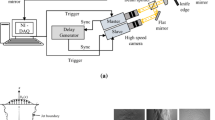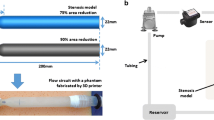Abstract
This study focuses on the measurement accuracy of Magnetic Resonance Velocimetry (MRV) in high-speed turbulent flows. One of the most prominent errors in MRV is the displacement error, which describes the misregistration of spatial coordinates and velocity components in moving fluids. Displacement errors are particularly critical for experiments with high flow velocity and high spatial resolution. The degree of displacement error also depends on the sequence structure of the MRV technique. In this study, two MRV sequence types are examined regarding their measurement capabilities in high-speed turbulent flows: a conventional MRV sequence based on the popular “4D FLOW” technique, and a newly developed sequence, named “SYNC SPI”. Compared to conventional MRV, SYNC SPI is designed for high measurement accuracy, and not for imaging speed, which limits its application to statistically stationary flows. Both sequence types are evaluated in a flow experiment with a converging–diverging nozzle. Time-averaged results are presented for velocities up to 12 m/s at the throat. Supported by Particle Imaging Velocimetry, it is shown that SYNC SPI is capable of acquiring accurate velocity data in these highly turbulent flows. In contrast, the data from the conventional MRV sequence exhibits substantial displacement errors with a maximum displacement of 21 mm. The long acquisition time is the main disadvantage of the SYNC SPI sequence. Therefore, it is examined if undersampling and non-linear reconstruction, known as Compressed Sensing, can be utilized to make data acquisition more efficient. In the presented measurements, Compressed Sensing is successfully applied to shorten the acquisition time by up to 70% with almost no reduction in measurement accuracy.
Graphic abstract












Similar content being viewed by others
References
Baek S, Lee S, Hwang W, Park JS (2019) Experimental and numerical investigation of the flow in a trailing edge ribbed internal cooling passage. J Turbomach 141(1):011–012
Bernstein MA, Shimakawa A, Pelc NJ (1992) Minimizing TE in moment-nulled or flow-encoded two-and three-dimensional gradient-echo imaging. J Magn Reson Imaging 2(5):583–588
Bruschewski M, Freudenhammer D, Buchenberg WB, Schiffer HP, Grundmann S (2016a) Estimation of the measurement uncertainty in magnetic resonance velocimetry based on statistical models. Exp Fluids 57(5):83
Bruschewski M, Scherhag C, Schiffer HP, Grundmann S (2016b) Influence of channel geometry and flow variables on cyclone cooling of turbine blades. J Turbomach 138(6):061,005–061,005
Bruschewski M, Kolkmannn H, John K, Grundmann S (2019) Phase-contrast single-point imaging with synchronized encoding: a more reliable technique for in vitro flow quantification. Magn Reson Med 81(5):2937–2946
Candes EJ, Romberg JK, Tao T (2006) Stable signal recovery from incomplete and inaccurate measurements. Commun Pure Appl Math J Issued Courant Inst Math Sci 59(8):1207–1223
Ching DS, Elkins CJ, Eaton JK (2018) Investigation of geometric sensitivity of a non-axisymmetric bump: 3d mean velocity measurements. Exp Fluids 59(9):143
Donoho DL et al (2006) Compressed sensing. IEEE Trans Inf Theory 52(4):1289–1306
Ehman RL, Felmlee JP (1990) Flow artifact reduction in MRI: a review of the roles of gradient moment nulling and spatial presaturation. Magn Reson Med 14(2):293–307
Elkins CJ, Alley MT (2007) Magnetic resonance velocimetry: applications of magnetic resonance imaging in the measurement of fluid motion. Exp Fluids 43(6):823–858
Elkins CJ, Alley MT, Saetran L, Eaton JK (2009) Three-dimensional magnetic resonance velocimetry measurements of turbulence quantities in complex flow. Exp Fluids 46(2):285–296
Freudenhammer D, Baum E, Peterson B, Böhm B, Jung B, Grundmann S (2014) Volumetric intake flow measurements of an IC engine using magnetic resonance velocimetry. Exp Fluids 55(5):1724
Grundmann S, Wassermann F, Lorenz R, Jung B, Tropea C (2012) Experimental investigation of helical structures in swirling flows. Int J Heat Fluid Flow 37:51–63
Holland DJ, Malioutov DM, Blake A, Sederman AJ, Gladden L (2010) Reducing data acquisition times in phase-encoded velocity imaging using compressed sensing. J Magn Reson 203(2):236–246
Jahangir S, Hogendoorn W, Poelma C (2018) Dynamics of partial cavitation in an axisymmetric converging–diverging nozzle. Int J Multiph Flow 106:34–45
Larson T 3rd, Kelly W, Ehman RL, Wehrli F (1990) Spatial misregistration of vascular flow during MR imaging of the CNS: cause and clinical significance. Am J Roentgenol 155(5):1117–1124
Layton KJ, Kroboth S, Jia F, Littin S, Yu H, Leupold J, Nielsen JF, Stöcker T, Zaitsev M (2017) Pulseq: a rapid and hardware-independent pulse sequence prototyping framework. Magn Reson Med 77(4):1544–1552
Lustig M, Donoho D, Pauly JM (2007) Sparse MRI: the application of compressed sensing for rapid MR imaging. Magn Reson Med 58(6):1182–1195
Lustig M, Donoho DL, Santos JM, Pauly JM (2008) Compressed sensing MRI. IEEE Signal Process Mag 25(2):72
Markl M, Frydrychowicz A, Kozerke S, Hope M, Wieben O (2012) 4D flow MRI. J Magn Reson Imaging 36(5):1015–1036
Nishimura DG, Jackson JI, Pauly JM (1991) On the nature and reduction of the displacement artifact in flow images. Magn Reson Med 22(2):481–492
Onstad AJ, Elkins CJ, Medina F, Wicker RB, Eaton JK (2011) Full-field measurements of flow through a scaled metal foam replica. Exp Fluids 50(6):1571–1585
Piro M, Wassermann F, Grundmann S, Leitch B, Tropea C (2016) Progress in on-going experimental and computational fluid dynamic investigations within a CANDU fuel channel. Nucl Eng Des 299:184–200
Untenberger M, Tan Z, Voit D, Joseph AA, Roeloffs V, Merboldt KD, Schätz S, Frahm J (2016) Advances in real-time phase-contrast flow MRI using asymmetric radial gradient echoes. Magn Reson Med 75(5):1901–1908
Wapler MC, Leupold J, Dragonu I, von Elverfeld D, Zaitsev M, Wallrabe U (2014) Magnetic properties of materials for MR engineering, micro-MR and beyond. J Magn Reson 242:233–242
Wassermann F, Hecker D, Jung B, Markl M, Seifert A, Grundmann S (2013) Phase-locked 3D3C-MRV measurements in a bi-stable fluidic oscillator. Exp Fluids 54(3):1487
Westerweel J, Scarano F (2005) Universal outlier detection for PIV data. Exp Fluids 39(6):1096–1100
Author information
Authors and Affiliations
Corresponding author
Additional information
Publisher's Note
Springer Nature remains neutral with regard to jurisdictional claims in published maps and institutional affiliations.
This work was supported by the Bundesministerium für Wirtschaft und Energie (BMWi) under Grant Number 20E1708 and ERC Consolidator Grant 725183 ‘OpaqueFlows’.
Rights and permissions
About this article
Cite this article
John, K., Jahangir, S., Gawandalkar, U. et al. Magnetic resonance velocimetry in high-speed turbulent flows: sources of measurement errors and a new approach for higher accuracy. Exp Fluids 61, 27 (2020). https://doi.org/10.1007/s00348-019-2849-4
Received:
Revised:
Accepted:
Published:
DOI: https://doi.org/10.1007/s00348-019-2849-4




